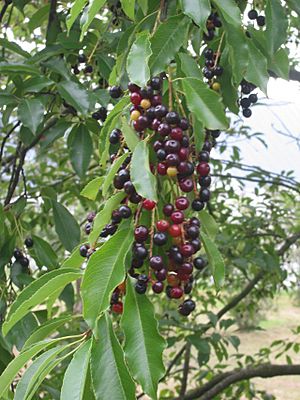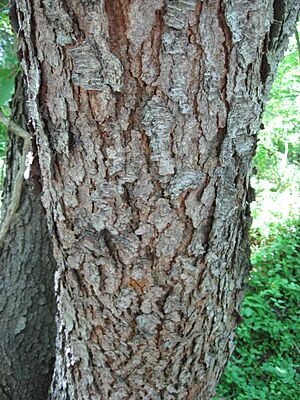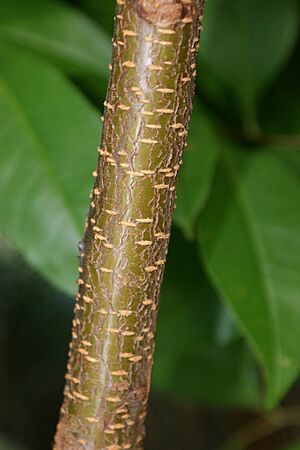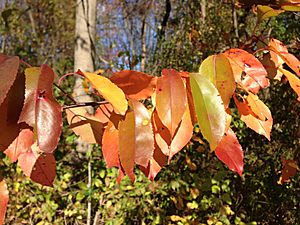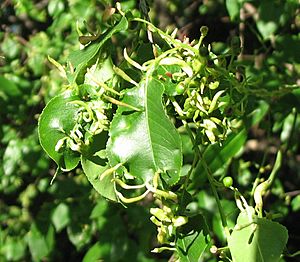Black cherry facts for kids
Quick facts for kids Black cherry |
|
|---|---|
 |
|
| Flowers and leaves | |
| Conservation status | |
| Scientific classification | |
| Genus: |
Prunus
|
| Species: |
serotina
|
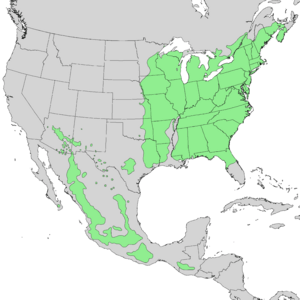 |
|
| Natural range | |
The black cherry (scientific name: Prunus serotina) is a type of tree or shrub. It is also known as wild black cherry, rum cherry, or mountain black cherry. This tree loses its leaves every year, which means it is a deciduous tree.
Even though it's called a black cherry, it's not closely related to the sweet cherries or sour cherries we often eat. Those cherries belong to a different group. Black cherry belongs to a group called Prunus subg. Padus. Other trees in this group include the Eurasian bird cherry and the chokecherry. You can find black cherry trees all over North and South America.
The black cherry is quite similar to the chokecherry. However, chokecherry trees are usually shorter. They are often shrubs or small trees. Their leaves are also smaller and not as shiny as the black cherry's.
Contents
What Does a Black Cherry Tree Look Like?
The black cherry tree is a medium-sized tree. It grows quickly in forests. These trees can reach heights of 15 to 24 meters (50 to 80 feet).
Its leaves are about 5 to 13 centimeters (2 to 5 inches) long. They are shaped like an oval with a pointed end. The edges of the leaves have small teeth. In the fall, the leaves turn yellow or red.
The flowers are small and white. Each flower has five petals. They grow in long clusters called racemes. These clusters are about 10 to 15 centimeters (4 to 6 inches) long. Each cluster can have many dozens of flowers.
After the flowers, small, round fruits grow. These fruits are called "berries" but are actually a type of fruit called a drupe. They are reddish-black when ripe. Birds love to eat them. Each fruit is about 5 to 10 millimeters (0.2 to 0.4 inches) wide.
When a black cherry tree is young, its bark is thin and smooth. It often has bands, looking a bit like a birch tree. As the tree gets older, its bark becomes very dark grey or black. It also gets rough and broken.
If you scratch a young twig and smell it, you might notice an almond-like scent. This is because the plant makes tiny amounts of cyanide compounds. These compounds help protect the tree from animals that might try to eat it.
Different Types of Black Cherry Trees
There are several different types of black cherry trees. These are called subspecies or varieties. They are found in different parts of North and South America. For example, some types grow in Mexico, while others are found in Texas or the southeastern United States. The most common type is found across Canada, the United States, Mexico, and Guatemala.
Where Black Cherry Trees Grow and How They Are Used
Black cherry trees are known as "pioneer species." This means they are often among the first trees to grow in open areas. You might see them in old fields or along roadsides. They like lots of sunlight. They often grow with other sun-loving trees like black walnut.
These trees can live for a long time, sometimes over 250 years. However, their branches can break easily in storms. Even if a branch breaks, the tree usually decays slowly.
Black cherry trees start making seeds when they are about 10 years old. They produce a lot of seeds after 30 years and can keep doing so for over 100 years. The seeds grow well, and birds and bears help spread them. Animals eat the fruit and then drop the seeds in new places. Some seeds can even stay in the soil for up to three years before they sprout. All cherry seeds have hard shells. They need to be scratched or softened to grow. In nature, this often happens when they pass through an animal's stomach.
Black cherry trees were brought to Europe in the mid-1900s. They were planted as ornamental trees because they look nice. However, in some places, they have become an invasive species. This means they spread quickly and can harm the local plants and animals. They can change the natural balance of the forest.
In Central and South America, one type of black cherry (Prunus serotina subsp. capuli) was grown for food long before Europeans arrived.
Deer also like to eat the leaves of black cherry trees.
Important Facts About Black Cherry Trees
Like apricots and apples, the seeds of black cherries contain special compounds. These compounds are called cyanogenic glycosides. They can turn into cyanide if the seed is crushed or ground up. This is because crushing the seed releases enzymes that break down the compounds.
However, the fleshy part of the cherry fruit is safe to eat. It does not have the enzymes needed to make cyanide. So, you can safely eat the fruit itself.
The leaves of the black cherry tree also contain these compounds. This is especially true when the leaves are wilted. If animals eat these wilted leaves, the compounds can turn into hydrogen cyanide. This can be harmful to them. Farmers are often advised to remove any black cherry trees that fall into fields where livestock graze. This helps keep the animals safe.
Pests and Diseases
Many types of caterpillars like to eat black cherry trees. For example, the eastern tent caterpillar can eat all the leaves off entire groups of trees in the spring. Black cherry trees can also get a disease called black knot. This disease causes black, lumpy growths on the branches.
How People Use Black Cherry Trees
Long ago, in Mexico, Native Americans called this tree "capolcuahuitl." They ate the berries as an important food.
The wood from the black cherry tree is also very valuable. It is often used to make beautiful cabinets and furniture in the U.S. This wood is known for its lovely orange color and can be quite expensive. Lower quality wood or the sapwood (the outer part of the wood) can be more tan. When dried, the wood is quite dense, weighing about 580 kilograms per cubic meter (36 pounds per cubic foot).
Sometimes, black cherry trees are planted just because they are attractive. They make nice additions to gardens and parks.
See also
 In Spanish: Cerezo negro americano para niños
In Spanish: Cerezo negro americano para niños



